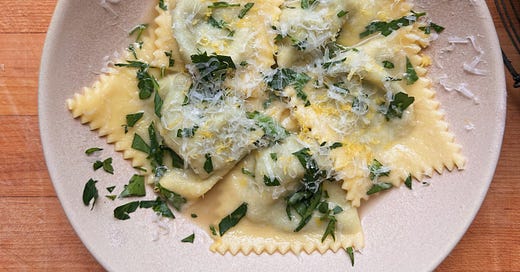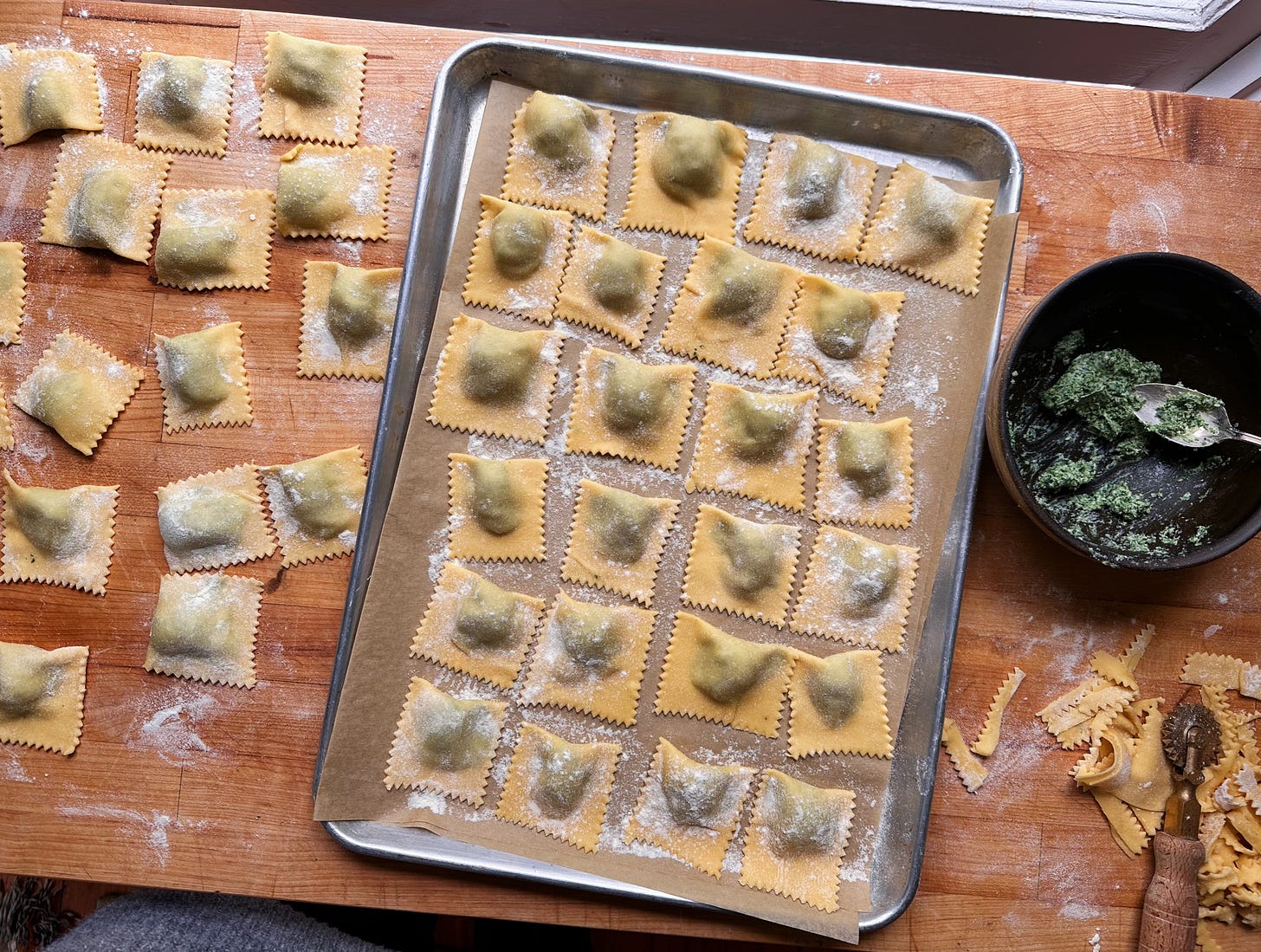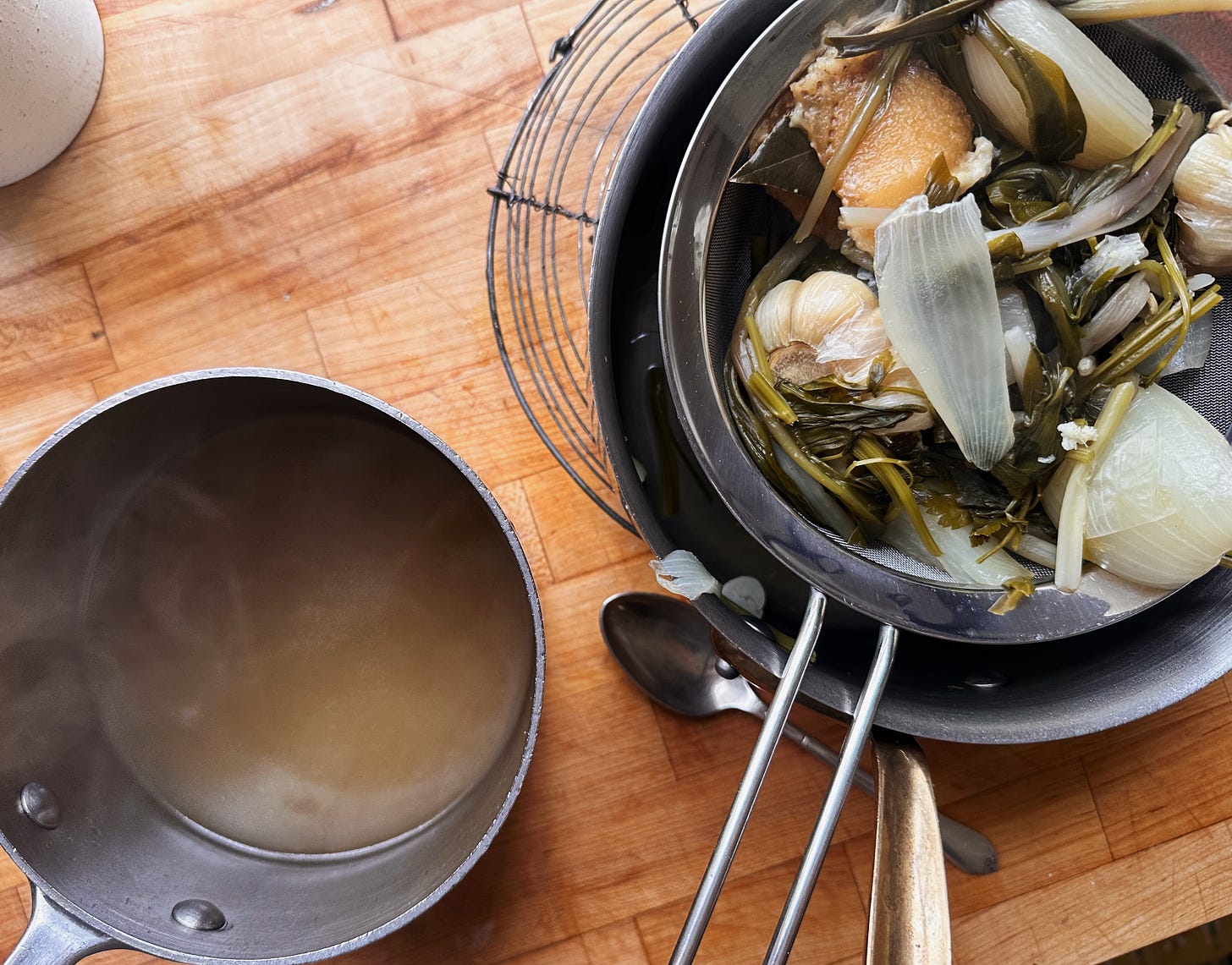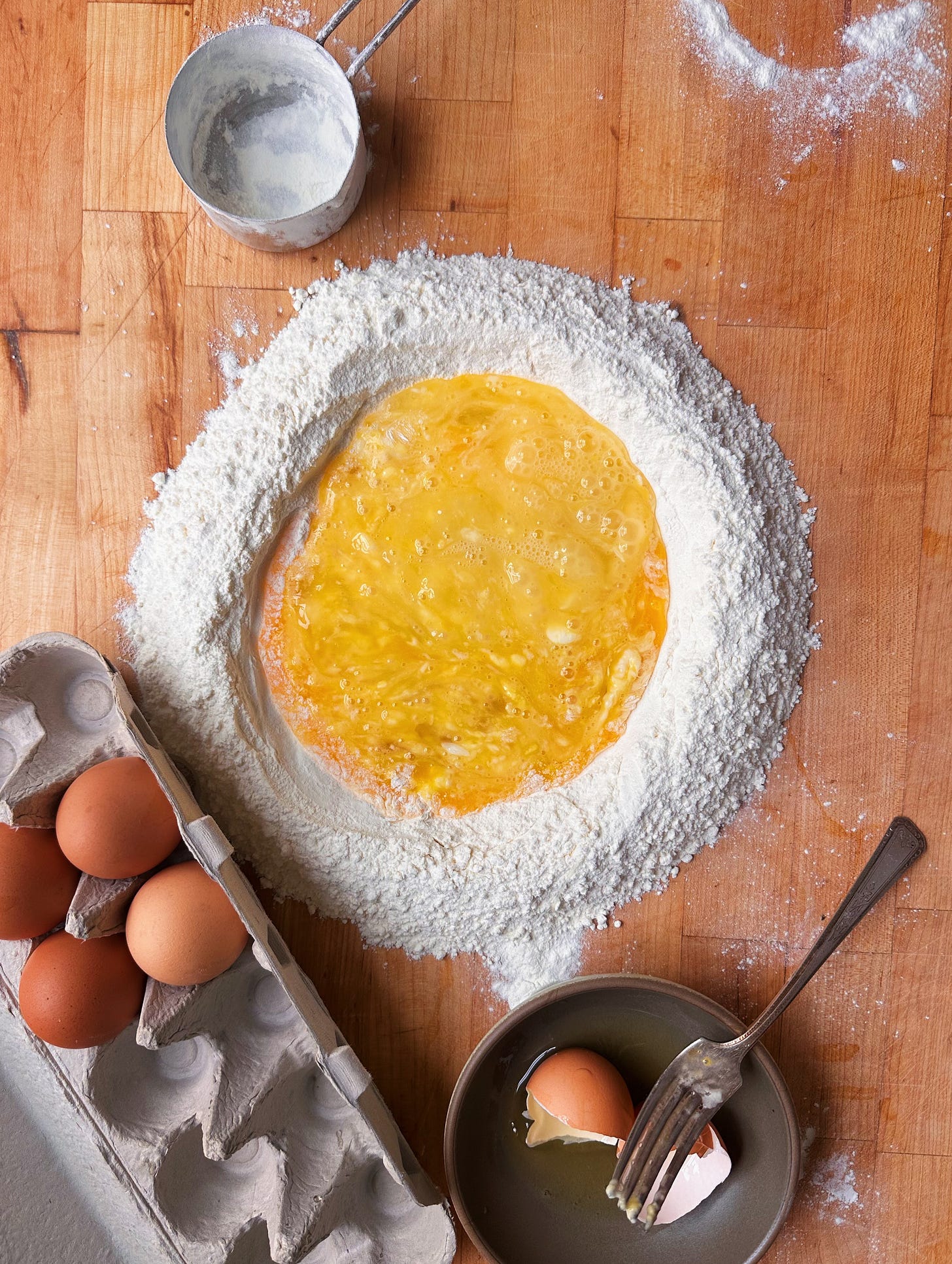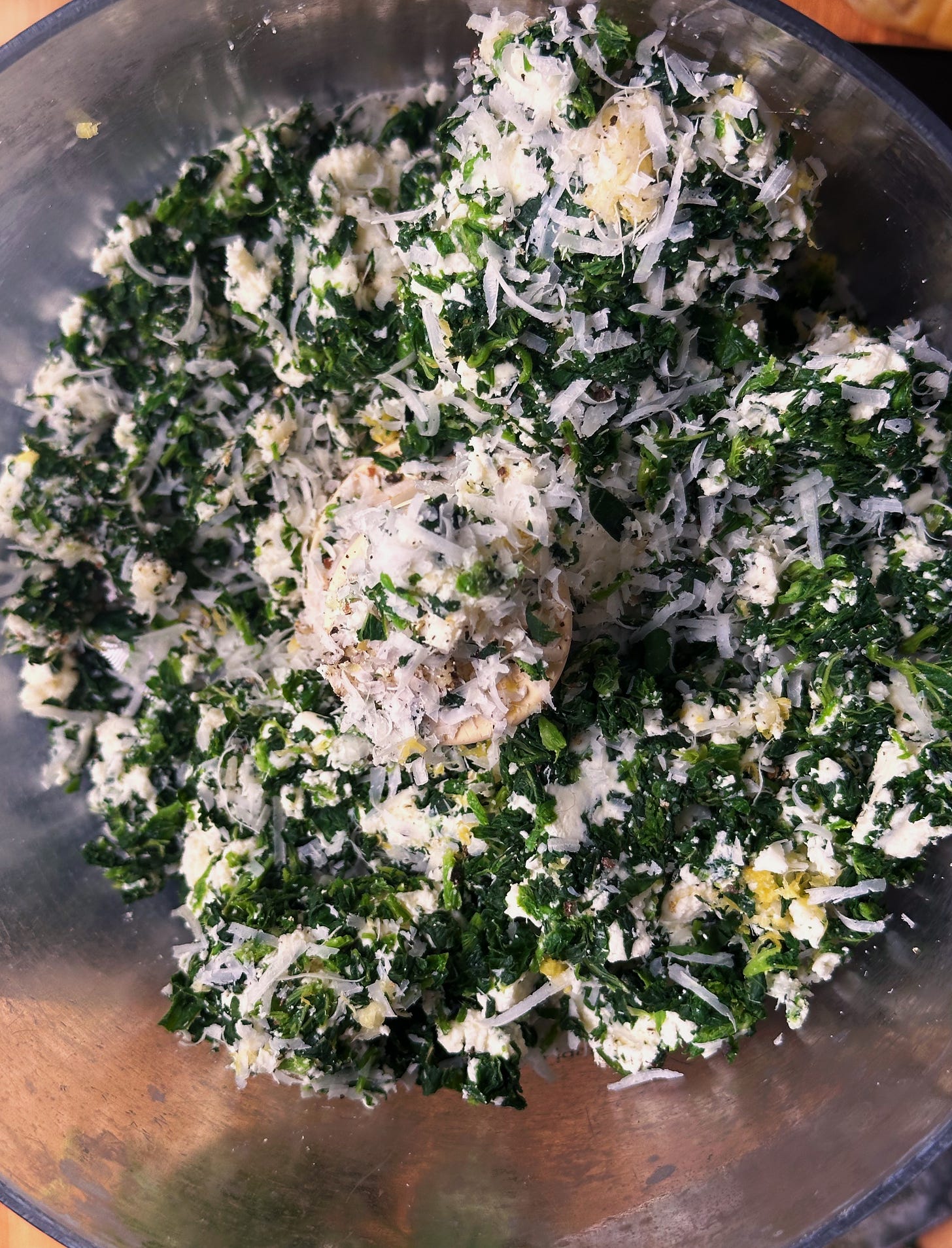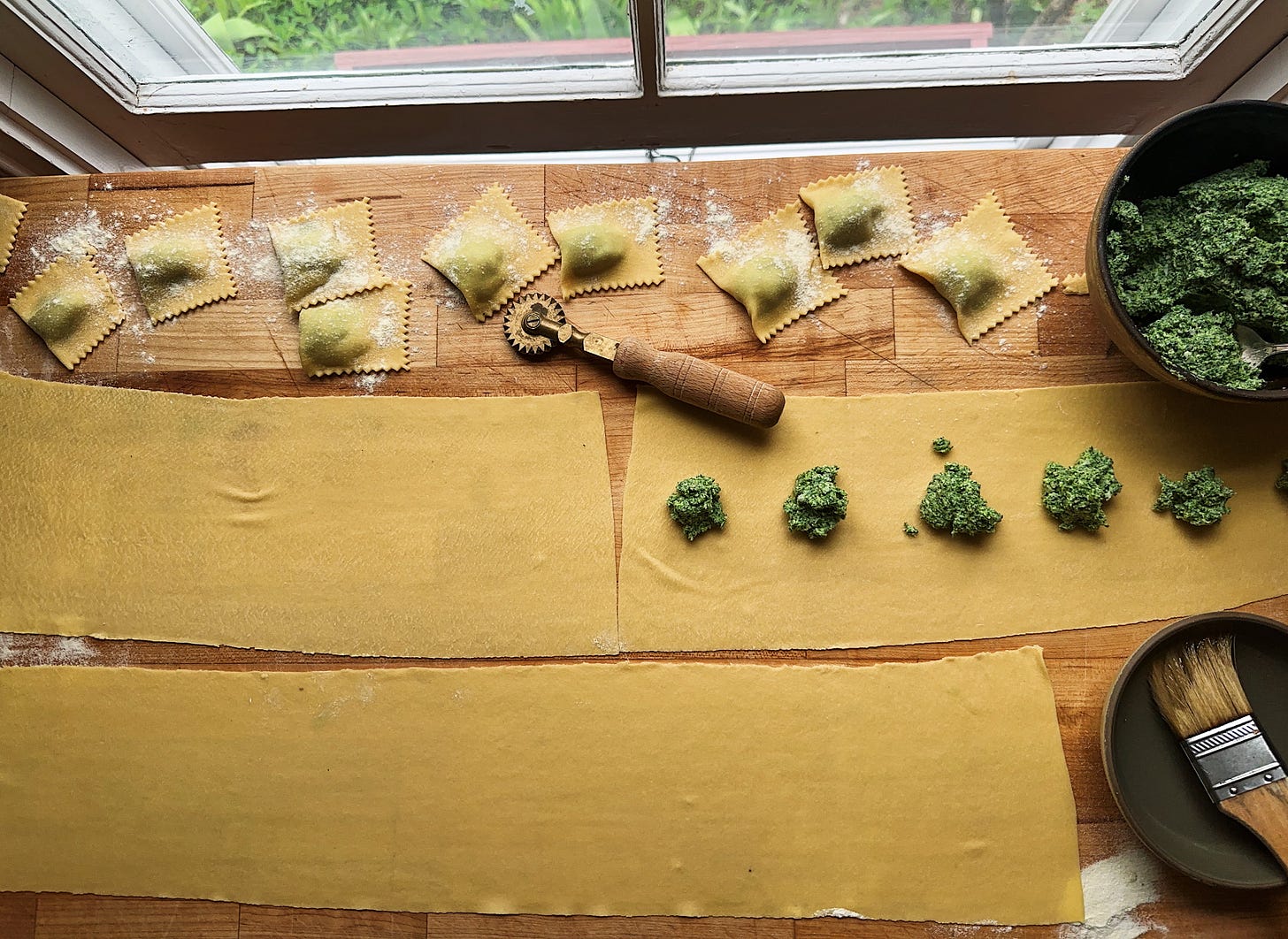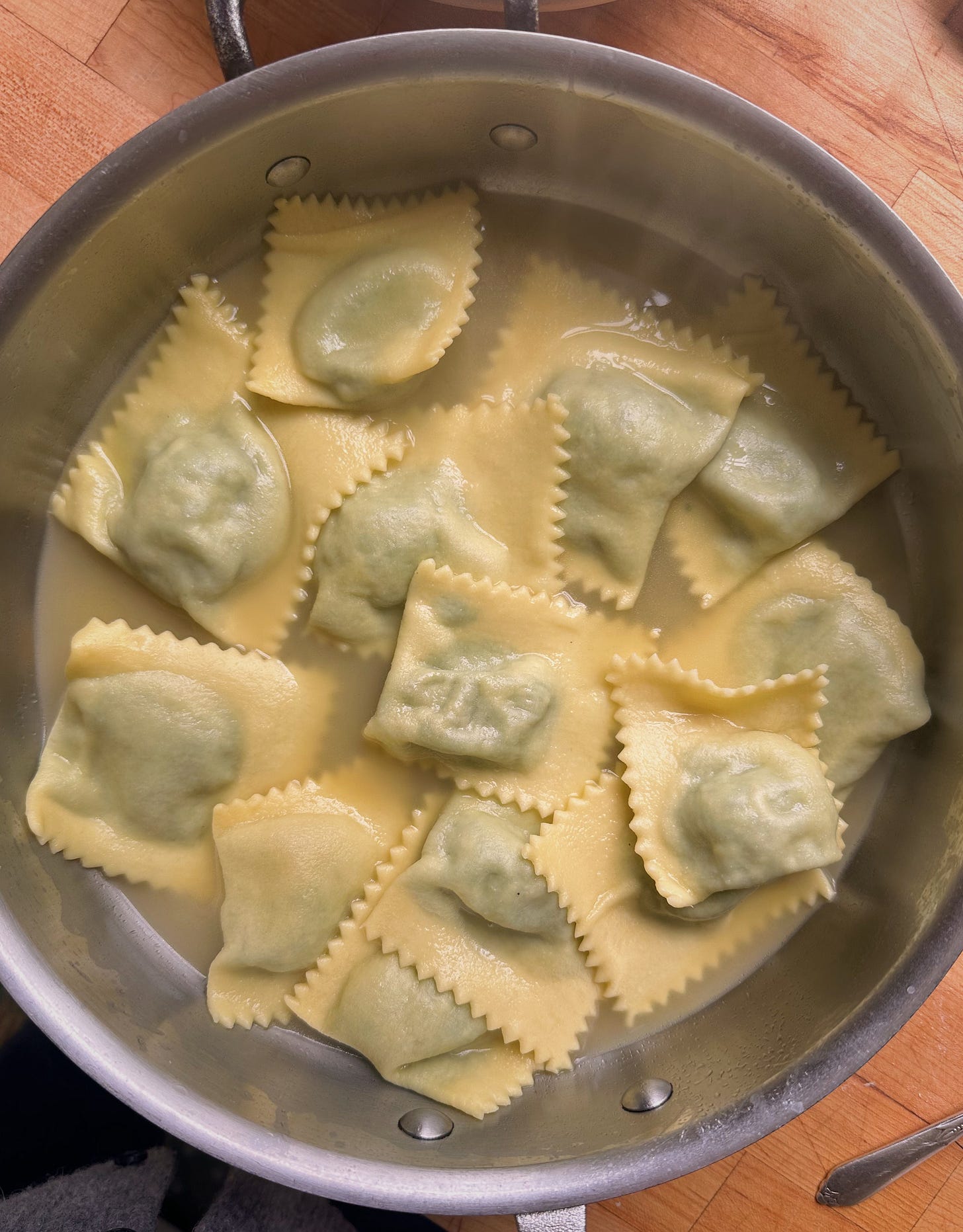Nettle Ravioli with Spring Parmesan Broth
every year we open the canteen with this dish on the menu
Just the other day I set out to harvest these nettles in a thick sweater and warm vest on a cool, grey morning. The nettles, like the ramps, are forageable delights that cue the arrival of spring—even if the trees up above still looked disappointingly bare. Yet this morning, only two days later and fittingly Earth Day no less, I was mesmerized by the buoyant shocks of green on my drive through the valley. It feels like overnight the trees opened up their blooms, and a young flush of leaves has replaced our brown landscape. Just like that, life has returned.
There’s a bop to my step that wasn’t there last week—spurred by a few 70-degree days, a vase of flowers in every room of my house, blue-sky days like today that inspire a margarita craving, and a sudden desire to have my fingers in the dirt. Better late than never, spring is here.
It seems to arrive this week every year. And I should know, because for the last few years we have opened the Canteen the week following my birthday. And most years, on my birthday, I lament the dreary delay of spring’s arrival, disappointed to spend it still dressed in warm layers. And yet every year, the following week, the temperatures rise just high enough and the landscape comes to life just in time for the opening of Westerly’s season.
I’m disappointed to not be opening the Canteen this week as we continue our search for a location. It feels wrong to not be harvesting cratefuls of ramps and nettles to put on the menu. It feels especially strange to not be stitching together the early spring crops into a full dinner menu, met by the enjoyment of familiar faces not seen since the fall. Or towing the Airstream out into the orchard. Or listening to Jordan on hold with Toast while we try to re-establish the Wi-Fi connection for our POS system. Or finding Alex in the field setting up our mini plot of flowers and tomatoes for the year. Because for the last few years, the late April flush of spring has become synonymous with all of these things for me.
My head understands that the work now is to find the next place where all of this will happen again—and more. And my heart knows to trust that some years are transition years, necessary for growth. But my hands… my hands want to be at work—chopping, and stirring, and rolling pasta. And so I let them. In much smaller quantities, they find their way to a dish that each year makes its way onto one of the first menus of the season. So in lieu of our opening weekend, you can perhaps enjoy this one at your home, until I can invite you back to mine.
Originally, this pasta was inspired by my favorite combination of nettles and ricotta from a beloved Chez Panisse signature pizza. Given that our nettle harvest on the East Coast often aligns with the unpredictable spring, I serve these ravioli in a simple broth of alliums and Parmesan rind that is both warming and springy, and complementary to the earthy flavor of nettles. Parmesan rind adds depth, umami, and a subtle nutty richness to an otherwise simple allium focused vegetable broth.
Lucky for me, nettles are popping up all over near my house. Foraged crops like nettles and ramps are especially valuable this time of year, when the farms are just beginning to stir and row crops are still a few weeks out. Most of the farmers markets near me don’t open until the first week of May, so harvesting what’s available—literally in my backyard—is a great way to cook seasonally while the farmers’ crops mature, still barely clear of frost. But be careful when you harvest nettles—they don’t call them stinging nettles for nothing, so wear gloves.
There are few tasks more soothing to me than rolling out fresh pasta. It’s a meditation. It’s a practiced skill but it doesn’t need to be intimidating. If you’re interested in diving deeper into the practice of homemade pasta, two resources I highly recommend are American Sfoglino by Evan Funke and Pasta by Missi Robbins
This recipe has a few steps—the dough, the filling, the broth, and bringing them all together. So it is a bit more of a process, but none of the components are hard to make. They’re all simple in nature, they just take a bit of time to come together. It’s the perfect dish for a Sunday. And it’s the perfect way to feel like you are back at the Canteen from your living room.
Nettle Ravioli with Spring Broth : The Recipe
Makes about 40 ravioli — serves 6, or freeze leftover ravioli for another time
Ingredients
For the Broth
Note: The alliums (shallot, onion, ramps) can be swapped for spring onions, leeks, or whatever you have around. A head of garlic can be replaced by a few stalks of green garlic. I often make this broth later in the spring using just spring onions and green garlic. The point is simply a plentiful mix of alliums and Parmesan rind.
1 shallot, halved
1 onion, quartered
1 bunch ramps or spring onions
1 head garlic, halved
4 bay leaves
2 pieces Parmesan rind (2–4 inches each)
Parsley stems
4 cups water
For the Pasta Dough
2 cups 00 flour (or 350 grams)
3 whole eggs + 1 egg yolk (about 205 grams)
Duro semolina for rolling
For the Filling
1 packed quart nettle leaves (about 150g dry) → yields ~¾ cup chopped nettles after blanching and squeezing
1½ cups ricotta or 10 oz of Chaseholm Farm cheese + ⅓ cup cream (to match ricotta consistency)
Zest of 1 lemon
2 tablespoons grated Parmesan
2 garlic cloves, grated or finely chopped
1 teaspoon black pepper
Salt, to taste
For Cooking and Serving
2-4 tablespoons butter
Chopped parsley, lemon zest, and grated Parmesan, for garnish
Process and Prep
Make the Broth
Wedge, halve, or roughly chop all the alliums; garlic and onions can keep their skins on. Cut Parmesan rind off a wedge of cheese.
Combine all alliums, Parmesan rind, bay leaves, parsley stems, and water in a medium pot.
Bring to a simmer and cook over medium heat for about 1 hour. It’s okay—and even encouraged—for the broth to reduce slightly. Taste for depth: if it still tastes weak, continue simmering. The Parmesan rind lends umami and richness, but sometimes the broth needs more than an hour to fully bloom.
Season with salt only at the end, as the Parmesan rind will have already added some salinity. Once seasoned to taste, let simmer for 5 more minutes, then strain and set aside. Yields about 3 cups.
Make the Pasta Dough
Mound the flour on your work surface and make a well in the center, wide and deep enough to hold the eggs.
Beat the eggs in a bowl and pour into the well.
Use a fork to slowly incorporate bits of flour from the inner walls into the eggs, until the eggs do not run.
When the eggs are the consistency of pancake batter, switch to a bench scraper (or continue with a fork) to bring it together into a shaggy mass.
Knead the dough with both hands, rotating a quarter turn after each fold, for 3–5 minutes until the dough is slightly tacky but compact.
Wrap tightly in plastic and let rest for 20 minutes.
Knead again for 2 minutes—by now, it should be smooth and uniform. If dry, lightly dampen your hands to continue kneading. After kneading this time you will notice that dough becomes smooth and uniform.
Wrap tightly in plastic again and let rest for 1 hour.
Make the Filling
Bring a medium pot of water to a rolling boil and prepare an ice bath.
Pick nettle leaves and blanch for 15 seconds. Transfer to the ice bath, then drain and squeeze dry—remove as much moisture as possible.
Finely chop the blanched nettles.
In a food processor, pulse ricotta with nettles, lemon zest, garlic, pepper, and parmesan until just smooth. Do not overmix.
Note: if you are using a drier cheese, like a farmers cheese from Chaseholm you will need to adjust the moisture content to match that of a ricotta by whipping in more heavy cream. Before adding the other ingredients to the food processor, pulse the cheese with the cream until just combined, and then add remaining ingredients.
Season filling to taste.
Build the Ravioli
Unwrap dough and divide in half.
On a semolina-dusted surface, roll out one half with a rolling pin until it fits into a tabletop pasta crank.
Run dough through the crank, starting at 0 and working up to a thinness similar to an index card. (On my crank this is setting 7—yours may vary.)
Lay dough sheet on a semolina-dusted surface (but don’t flour the top side).
Repeat with other half of dough.
Dollop filling (1 heaping teaspoon each) spaced 1 inch apart down the center of each sheet.
Lightly moisten around each dollop with water using a pastry brush or spray bottle.
Fold the sheet over itself and press to seal around the filling.
Use a fluted cutter to trim and shape ravioli.
Place finished ravioli on a semolina-floured baking sheet until ready to cook. They freeze beautifully like this.
Cook and Serve
Unless you have a large braising pan or rondeau, you’ll want to work in batches if cooking all the ravioli for a crowd—it’s a lot to manage at once! Given how many ravioli this recipe yields, you may also opt to cook just a portion and freeze the rest. The following instructions are for cooking 12–14 ravioli (about a third of the recipe), which feeds two people, generously, with a proportionate amount of broth and butter. Scale broth and butter as needed to amount of ravioli cooked.
Bring a large pot of heavily salted water to a boil—it should taste like the sea.
In a large saucepan, bring 1 cup of broth to a simmer and whisk in 2 tablespoons butter. Let reduce slightly while the pasta cooks, creating something between a sauce and a broth.
Drop 12-14 ravioli into the pot of boiling water for 2 people. If cooking pasta you have made today, cook for 3 minutes. If cooking from frozen, cook for 5 1/2.
Use a slotted spoon or spider to transfer ravioli to the simmering broth. Baste gently in the broth to coat.
Serve in shallow bowls, topped with chopped parsley, lemon zest, and Parmesan.

